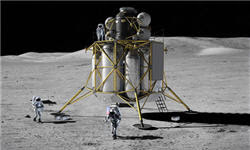 By Frank Morring, Jr.
By Frank Morring, Jr.Aviation Week
An in-house NASA design team that is sketching out a rough concept for the planned Altair lunar lander will soon be joined by some early industry partners to help with a "minimum functional" design that will be the starting point for an actual lander.
To get to a working vehicle, NASA already knows it needs to trim about three metric tons from its concept, with propulsion systems the biggest opportunity for weight-saving.
The Constellation Program at Johnson Space Center (JSC) in Houston issued a broad area announcement in January for industry participation in setting that starting point, and received more than 30 responses, according to Clint Dorris, deputy Altair project manager. Contracts of no more than $350,000, for a total of no more than $1.5 million, will be issued by the middle of March.
The idea is to develop an early lander concept that meets the basic requirements of a seven-day stay on the lunar surface with a crew of four, and that can be grown into a lander that can go anywhere on the lunar surface. Once the single-string concept vehicle is set, the project plans to buy redundancy and functionality with hardware add-ons while still meeting the 45 metric-ton weight limit.
A full-scale system requirements review is anticipated in 2009, and in 2009-11 the project hopes to do some testbed work that will build confidence in technologies. Dorris says the biggest opportunity for improvement lies in propellant mass, and the propulsion system itself - the first- and second-heaviest vehicle elements, respectively.
Early concepts see most of the vehicle taken up with the descent stage, which will get the crew down safely and accommodate them on the surface for a week. The ascent stage is tiny, with a habitable volume of only nine or 10 cubic meters. "It's not much larger than required to hold the avionics and four people standing up," Dorris says. "That's where you start taking [weight] penalty - getting too large on that vehicle."
Currently the ascent module is allocated 5,075 kilograms (11,200 pounds), while the descent module weighs in at 32,718 kilograms (72,130 pounds). A separate airlock module that will stay behind on the moon and eventually be shared with future habitation modules in a lunar outpost is budgeted at 949 kilograms (2,090 pounds), leaving 3,401 kilograms (7,500 pounds) for payload and a 2,857-kilogram (6,300-pound) project manager's reserve.
The descent module will be powered by a derivative of the RL-10 rocket that can be deeply throttled for landing control. The ascent module uses a 5,500-pound thrust hypergolic engine, and docks with the Altair using the Low Impact Docking System under development at JSC.

No comments:
Post a Comment